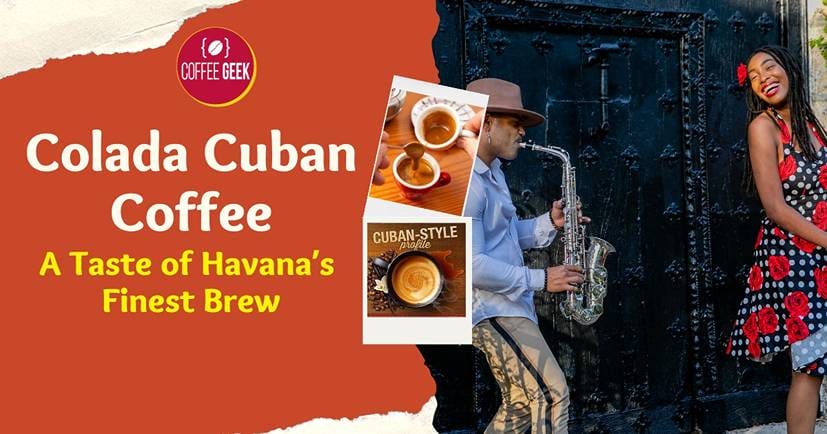Colada Cuban coffee is a delicious and strong, sugar-laden espresso found predominantly in Cuban communities.
As a vital part of Cuban culture introduced to the United States through Miami’s thriving Cuban population, this unique coffee drink has earned quite a reputation.
The preparation and sharing of colada fuels socialization and close relations, making it a symbol of togetherness and hospitality.
It all starts with the right beans, tools, and techniques. Essential to the colada’s distinct flavor are Cuban coffee beans, usually Arabica, grown in the Sierra Maestra region of Cuba.
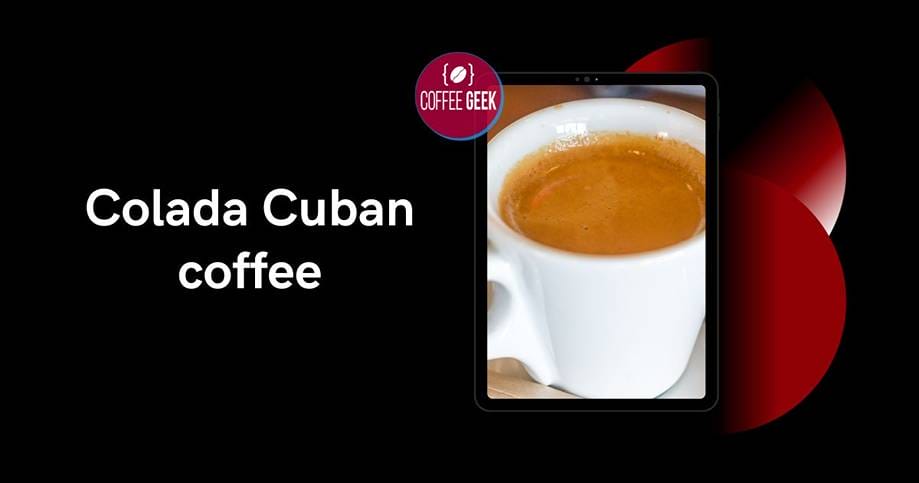
With the help of a traditional stovetop espresso maker called a Moka pot, you can create an impressive foam, known as espumita, by mixing the first few drops of strong brewed coffee with sugar.
Following the recipe and adjusting the sugar-to-coffee ratio according to taste is key to getting that authentic colada experience.
Key Takeaways
Colada Cuban coffee is a strong, sweet espresso deeply rooted in Cuban culture and symbolizes togetherness and hospitality.
The drink is made using Cuban Arabica beans and a traditional stovetop espresso maker called a Moka pot to create a sweet note, strong coffee with a unique foam called espumita.
Understanding the brewing process, essential ingredients, and the importance of sharing are all crucial aspects of the authentic Cuban coffee colada experience.
- The Origin of Cuban Coffee
- Cuban Coffee in Miami
- Defining Colada and Other Cuban Coffee Terms
- Essential Ingredients and Tools for Making Cuban Espresso Coffee
- The Flavor, Customs and Sharing of the Colada Cuban Coffee
- The Brewing Process and Recipe for Cuban Coffee Colada
- Popular Cuban Coffee Brands
- Conclusion
- Frequently Asked Questions
The Origin of Cuban Coffee
Cuban coffee, also known as Cafecito or Café Cubano, is a delicious and unique espresso that originates from the beautiful island of Cuba.
The rich coffee culture in this Caribbean nation has deep historical roots, making it an essential part of Cuban identity.
Spanish settlers first introduced coffee to Cuba in the 18th century, and by the 19th century, the coffee industry was thriving, particularly in the Sierra Maestra region.
Over time, the coffee culture in Cuba developed into something truly special, setting it apart from other countries.
In Cuba, coffee is more than just a drink; it’s a way of life. Cuban coffee culture is all about coming together, socializing, and taking a moment to savor the bold flavors, like the sweetened espresso shot known as Colada.
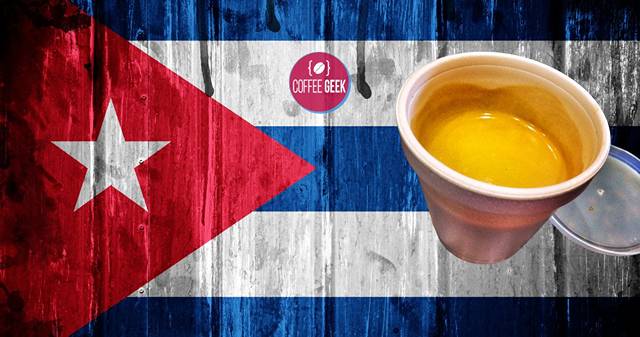
As you enjoy this delightful brew, you’ll notice the signature espumita or foam, which is crucial for a perfect Cafecito.
The turbulent political events of the 20th century, such as the Cuban Revolution, had a significant impact on the country’s coffee industry.
Despite this, the traditions of Cuban coffee culture have survived and even flourished in Cuban communities around the world.
Nowadays, the Cuban-American population in places like Miami and other cities in the U.S. are keeping the vibrant coffee culture alive and thriving.
So, the next time you savor a delicious cup of Cuban coffee, take a moment to appreciate the rich history and culture that have shaped this unique and flavorful espresso experience. Enjoy!
Cuban Coffee in Miami
When you’re in Miami, you can’t miss the taste and aroma of Cuban coffee. The city’s communities have brought their cafecito culture to South Florida, spreading the love for strong coffee and lively conversation.
Here are some places and ways to enjoy this beloved ritual in Miami.
Little Havana, one of the most popular neighborhoods representing Cuban inhabitants, offers the classic Cuban colada served in many local cafeterias.

Get ready to try a cafecito or a colada in Little Havana, an area filled with vibrant culture, colorful murals, and authentic Cuban food.
One of the must-visit locations there is Versailles Restaurant, known for its excellent Cuban coffee and traditional Cuban cuisine.
Another notable spot is Old’s Havana Cuban Bar & Cocina, offering a cozy atmosphere with live music and delicious colada.
Miami’s unique Cuban coffee shops often feature “ventanitas,” or walk-up windows, where you can order your coffee and interact with friends, strangers, and locals alike.
It’s a tradition cherished by the community, and it’s an excellent opportunity for you to immerse yourself in South Florida’s lively cafecito scene.

Places like Puerto Sagua in Miami Beach has become a staple for coffee lovers, always bustling with people looking for a quick caffeine fix.
Cuban culture isn’t just about the taste; it’s about the experience of bonding with your friends and neighbors.
As you explore the Cuban coffee scene in Miami, take time to engage in conversation, create connections, and enjoy the atmosphere in Little Havana, ventanitas, and beyond.
Miami is a place where people from all walks of life come together to share in the delight of a perfect cup of Cuban coffee.
Defining Colada and Other Cuban Coffee Terms
Colada or Cafecito is a type of Cuban coffee. It is made by brewing strong coffee in a stovetop percolator, also known as “la cafetera,” and is traditionally consumed in small portions called “tacitas.”
The significant aspect of colada coffee is its rich and sweet taste, achieved by mixing granulated sugar with the coffee to create a crema, or “espumita.”
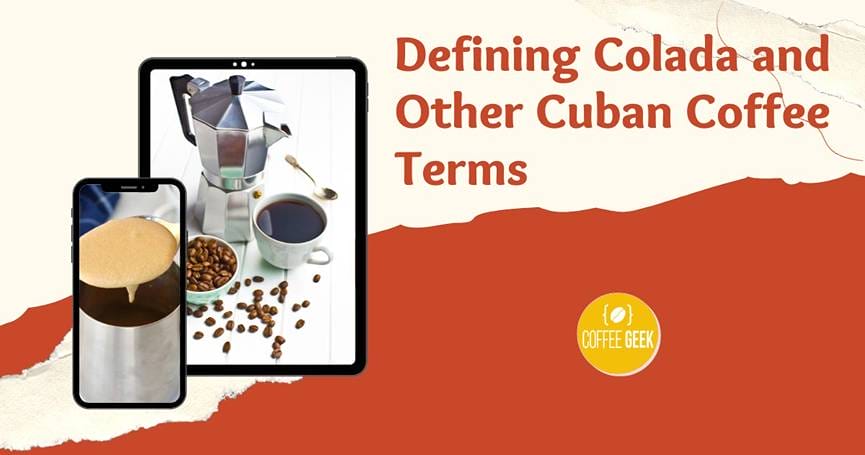
A close relative of colada is Café Cubano, which is similar in taste and preparation but served as a larger shot compared to the colada coffee.
Another popular type of Cuban coffee is the Cortadito, which is a smaller version of the Cuban coffee, made by adding a splash of steamed hot milk. It is similar to an espresso macchiato but with a unique Cuban twist.
On the other hand, Café con Leche is a Cuban-style latte that consists of coffee and milk in equal parts.
It is traditionally served in a larger styrofoam cup rather than the small tacitas and makes for a perfect morning beverage.
The key difference here is that Cuban espresso is the base of Café con Leche, unlike regular lattes.
Espuma, or foam, plays an essential role in Cuban coffee, especially when it comes to colada and café cubano.

The sugar is whipped into a frothy texture, creating the distinctive espumita that tops these coffee drinks.
Natural brown sugar or demerara sugar is preferred over granulated sugar for its rich flavor and its ability to produce a thicker, creamier foam.
To sum up, Cuban coffee comes in various forms – colada, café cubano, cortadito, and café con leche – each with its signature twist and preparation method.
Enjoy the rich, sweet taste of colada or share some tacitas with friends when you want to experience the unique coffee Cuban culture!
Essential Ingredients and Tools for Making Cuban Espresso Coffee
Preparing a delicious and authentic Cuban coffee, or colada, requires a few essential ingredients and tools. Here, we will guide you through the process and what you’ll need to make this delightful beverage at home.
First, gather your ingredients and tools. High-quality Cuban espresso beans are essential, such as Mayorga Café Cubano.
Make sure you have fresh coffee grounds or grind your own beans to get the most flavor out of your coffee. Arabica beans are generally the preferred choice for Cuban espresso.
Additionally, you’ll need sugar (typically brown sugar) to create the essential espumita, or sugar foam, which adds a sweet and frothy touch to the colada.
Next, let us discuss the tools needed for brewing Cuban coffee. Consider using a Moka pot or a stove-top espresso maker like Bialetti, which ensures authentic preparation.
These devices, known in Cuba as cafeteras, are widely used for making Cuban-style coffee and are perfect for achieving a strong, flavorful brew.
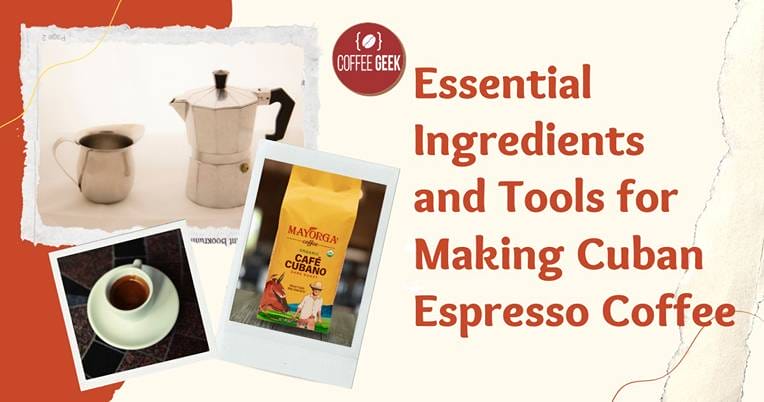
Filtered water is always a good choice for any coffee preparation, as it ensures a clean and balanced taste. When it comes to serving your colada, you’ll need shot glasses or demitasse cups for the traditional presentation.
Another essential aspect of the Cuban coffee process is tamping the ground coffee. This step involves gently pressing the coffee grounds down into the portafilter for proper extraction in the espresso machine.
A pilon, typically used for grinding spices, can also be used to grind the coffee beans for your colada.
If you prefer a milky variant of the colada, consider adding steamed milk or frothed milk to create a creamy and smooth texture.
However, traditional Cuban coffee does not contain milk, and the colada is often enjoyed as a strong, intense shot.
Now that you’re equipped with the essential ingredients and tools, you’re ready to make your own delightful colada and share it with friends and family. Enjoy your Cuban coffee experience!
The Flavor, Customs and Sharing of the Colada Cuban Coffee
When you enjoy a colada, you are not just sipping on a cup of coffee. You are partaking in a cherished Cuban custom that revolves around sharing, socializing, and savoring a unique flavor.
Colada coffee is a strong and sweet Cuban espresso drink typically served in shot-sized portions with a rich crema on top.
While hanging out at ventanitas (window cafes) in Cuban neighborhoods, you might notice locals sharing a colada with friends and family.
This custom of sharing colada coffee is deeply ingrained in Cuban culture, fostering a sense of connection and community.
To truly appreciate the colada experience, make sure to pair it with a delicious pastelito, a Cuban pastry often filled with guava or cheese.
The combination of the coffee’s bold flavors with the sweetness of the pastelito creates a delightful and satisfying taste sensation.
The unique flavor of a Cuban coffee colada comes from the use of both Arabica and Robusta beans grown in Cuba, with the best quality beans hailing from the Sierra Maestra region.
The coffee is brewed using a stovetop percolator espresso maker called a cafetera, adding brown sugar to the brewing process to enhance its sweetness.
As you can see, the colada is more than just a coffee – it’s an experience steeped in Cuban customs and traditions.
So next time you come across a ventanita or have the opportunity to taste a colada coffee, make sure to share it with your friends and loved ones, creating memories along with a delicious, unique espresso.
| Aspect | Description |
|---|---|
| Name | Colada Cuban Coffee |
| Origin | Cuba |
| Type | Espresso-based coffee |
| Ingredients | Espresso coffee, typically sweetened with sugar |
| Preparation | Brewed using finely ground Cuban coffee beans |
| Serving Size | Typically served in small, espresso-sized cups |
| Presentation | Often served with small plastic cups for sharing |
| Cultural Significance | Popular in Cuban communities, often shared among friends and family |
| Flavor Profile | Strong, bold, and sweet |
| Customization | Can be customized with varying levels of sugar |
| Traditional Ritual | Commonly shared among colleagues or friends, fostering a sense of community |
| Accompaniments | Sometimes served with a glass of water to cleanse the palate |
| Variations | Some may add a dash of milk or foam for variety |
| Popular Phrases | “Let’s grab a colada!” |
| Café Cubano | Similar to a colada but typically served in a smaller cup, with a thicker layer of sweetened espresso at the bottom |
The Brewing Process and Recipe for Cuban Coffee Colada
Cuban Coffee Colada, also known as Colada or Café Cubano, is a delicious and strong coffee drink served in shot-sized portions.
The unique and scrumptious taste of drinking Café Cubano comes from the harmonious blend of potent, dark roast espresso and luscious sugar foam called espumita. To make your own Colada at home, just follow these simple steps.
First, gather your ingredients: ground coffee (preferably dark roast Cuban coffee beans like Café Bustelo), brown sugar, and water.
You will also need a Moka pot or an espresso machine for brewing your coffee. Remember, using fresh, high-quality coffee grounds can make a big difference in the flavor of your Colada.
Begin the brewing process by filling the bottom chamber of your Moka pot with water, just below the pressure valve. Then, fill the coffee basket with finely ground coffee, allowing it to form a small mound.
Place the coffee basket into the bottom chamber of the Moka pot and screw the top chamber back on. Put the Moka pot on medium heat and wait for your delicious espresso to brew.
While you wait, prepare the sugar foam or espumita. In a separate cup, add brown sugar – about 1 tablespoon per 2-ounce serving of espresso.
Once the magic begins and your espresso starts brewing, take a small amount of the rich crema (brewed coffee with froth) from the top of your Moka pot and add it to the sugar.
It’s essential to use only the darkest and densest part of the coffee.
Now, mix the sugar and crema together vigorously until you achieve a thick, light brown foam. This step is crucial for creating the characteristic rich taste and texture of a Cuban Coffee Colada.
When your espresso has finished brewing, pour it slowly into the cup containing the sugar foam mix. The espresso will blend with the espumita, creating a delectable, frothy layer on top of your Colada.
That’s it! Your homemade Cuban Coffee Colada is ready to be served.
Get out some small cups or shots glasses and share this delightful treat with friends and family. Enjoy the authentic taste of Cuban culture you’ve just created in your own kitchen.
Popular Cuban Coffee Brands
If you’re a fan of Cuban coffee, you’re probably familiar with the rich and bold flavors that come with each sip. In this section, we’ll introduce you to some popular Cuban coffee brands that you might want to try.
One well-known brand in the Cuban coffee scene is Supreme by Bustelo Espresso Style Ground Coffee.
This dark roast blend is crafted from 100% Arabica coffee beans, offering a rich, deep, and full-bodied taste.
As an espresso-style coffee, it’s perfect for those who love their beverage with a robust flavor profile.
Another brand that consistently ranks high on the list of best Cuban coffees is Mayorga Café Cubano.
Mayorga offers a unique blend of coffee beans sourced from Central and South America, providing a bold flavor with a smooth finish.
If you’re looking to try something new within the realm of Cuban coffee, Mayorga Cafe Cubano might just be right up your alley.
You might also want to consider Café Bustelo Cuban for your next coffee experience.
This brand offers an authentic taste of Cuban-style coffee that’s perfect for those looking to recreate the experience of sipping coffee at a Havana café.
Keep in mind that Café Bustelo Cuban is known for its powerful taste, so it may not be the best option for coffee drinkers who prefer a milder flavor.
If you’re in the mood for something a bit different, give Cafe La Llave a try. This brand features a blend of dark roasted coffee beans that produces a smooth, aromatic, and full-bodied cup of espresso.
It’s a favorite among Cuban coffee enthusiasts who enjoy a rich and satisfying brew.
Finally, don’t forget about Pilon when exploring your Cuban coffee options.
This brand provides a rich, dark roast that promises an intense flavor experience with every cup. Pilon is the choice for those who enjoy bolder flavors in their coffee.
As you venture into the world of Cuban coffee and explore these brands, you’re bound to find one that perfectly suits your taste buds.
Whether you prefer a bold, intense flavor or something more subtle and smooth, there’s a Cuban coffee brand out there just waiting for you to discover it. Happy sipping!
Conclusion
Colada Cuban Coffee is a distinctive style of coffee that stands out for its method of preparation and the way it is served. At its core, it is an espresso shot, strong one, richer and more potent than regular coffee, often associated with the social aspects of Cuban culture.
Frequently Asked Questions
How to make colada coffee at home?
To make colada coffee at home, you’ll need a Moka pot, Cuban coffee beans, and brown sugar. First, grind the coffee beans to a fine consistency.
Fill the bottom chamber of your Moka pot with water and the coffee grounds in the filter. Add a teaspoon of brown sugar. Place the Moka pot on the stove over heat medium.
As the coffee brews, the sugar will dissolve and create a rich, sweet crema on top. Pour the colada into small espresso cups or shot glasses to share with your friends and family.
What is the difference between colada and the delicious coffee beverage cortadito?
While both colada and cortadito are made from Cuban espresso, the main difference is in the amount of milk each contains. Colada is a strong Cuban coffee, sweet coffee served in shot-sized portions, with little to no milk.
On the other hand, a cortadito is espresso mixed with a small amount of steamed milk, making it a bit lighter and creamier than colada.
Which are the top Cuban coffee brands?
Some popular Cuban coffee brands include Café Bustelo, Café La Llave, and Café Pilon. These brands offer a rich, bold flavor that is characteristic of Cuban coffee.
What’s the best method to prepare colada without an espresso maker?
If you don’t have an espresso maker, a Moka pot is an excellent alternative to prepare colada coffee. Moka pots closely replicate the brewing process of an espresso machine, allowing you to achieve similar results.
What distinguishes colada coffee from other espresso drinks?
What sets colada coffee apart from other espresso drinks is its unique preparation which involves the addition of brown sugar during the brewing process.
This results in a sweet and strong coffee with a distinctive crema on top.
Also, colada coffee is typically served in small, shot-sized portions meant for sharing, highlighting the social aspect of the culture of Cuban coffee.
Where can I find colada Cuban cafes in Florida?
Florida, especially Miami, is home to a thriving Cuban coffee scene.
You can find colada and other Cuban coffee drinks at places like Versailles, La Carreta, Enriqueta’s Sandwich Shop, and many other cafes and restaurants serving Cuban cuisine throughout the state.

